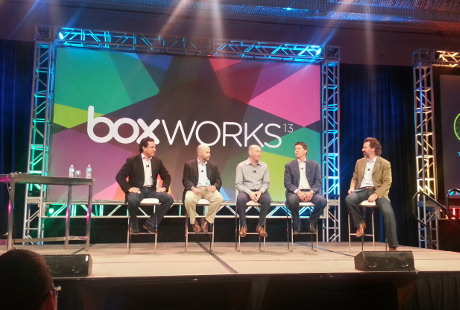“What is your one prediction for the cloud world in the next five to ten years?” That is the question that Dan Levin, co-founder and COO of cloud-based content sharing service Box asked a panel of tech executives at the company’s BoxWorks event in San Francisco yesterday.
Evan Goldberg, CTO of finance SaaS provider Netsuite, predicted that the first examples of Fortune 500 companies that move their IT completely to the cloud will soon begin to emerge.
Lanham Napier, CEO of hosting provider Rackspace, said he believes that open source technologies will come to dominate.
And social collaboration Jive Software CEO Tony Zingale predicted the demise of email as a means of community. Email will “get cut in half over the next five years,” Zingale said. It may not die out altogether, he said, “but email will be put on a server in a back room”.
Keith Krach, CEO of electronic signature provider DocuSign, said the cloud is going to transform the perception of IT.
The corporate world “has a negative view of corporate IT, but the cloud is going to change that,” Krach said. “I’m optimistic about cloud’s role for the enterprise IT profession.”
He argued that IT departments of the future are likely to revolve around developers, without the need for administrators or operations specialists. Those developers will in turn drive cloud technology adoption and speed up the pace of innovation.
“It will be so easy and fast to spin up a server, there will be so many resources available,” he said. “IT departments have a wonderful opportunity to embrace that.”
NetSuite’s Goldberg agreed, adding that as IT departments are freed up from “spending time screwing servers in”, they will be more involved in solving business problems.
Zingale argued that the much-lauded shift towards the public utility model for data in a similar vein to electricity and telecoms is likely to accelerate all of this.
“It’s a complex system and it’s early days, but really it’s no different to any other utility like electricity or water,” he said. “It’ll take us a while to figure out, but I have great faith in the ingenuity of engineers.”
This will also drive demand for a next generation stack of both applications and infrastructure, said Zingale. “There needs to be a more fundamental cloud architecture developed that’s more cloud-centric than the one we have today,” added Levin.
But Zingale pointed out that while many more traditional companies are moving to the cloud and “investing hundreds of million” in cloud technologies such as Salesforce and similar for internal communications and analytics, “when it comes to transacting with customers, partners, suppliers at the point of transaction, it breaks down, they’re not trusting in cloud in a serious way.”







